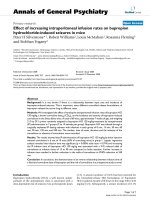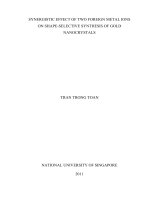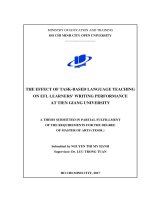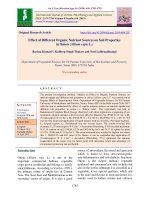Effect of seedling dip and pre harvest foliar application of growth regulators and fungicide on sprouting and chemical parameters in onion (Allium cepa L.) var. Arka Kalyan
Bạn đang xem bản rút gọn của tài liệu. Xem và tải ngay bản đầy đủ của tài liệu tại đây (205.6 KB, 6 trang )
Int.J.Curr.Microbiol.App.Sci (2019) 8(4): 970-975
International Journal of Current Microbiology and Applied Sciences
ISSN: 2319-7706 Volume 8 Number 04 (2019)
Journal homepage:
Original Research Article
/>
Effect of Seedling Dip and Pre Harvest Foliar Application of Growth
Regulators and Fungicide on Sprouting and Chemical Parameters in Onion
(Allium cepa L.) var. Arka Kalyan
Ayeeshya Hasansab Kolhar*, S.L. Jagadeesh and Vijaymahantesh
College of Horticulture, Bagalkot, University of Horticultural Sciences,
Bagalkot-587104, Karnataka, India
*Corresponding author
ABSTRACT
Keywords
Onion, Salicylic
acid, Azoxystrobin
and Cycocel
Article Info
Accepted:
10 March 2019
Available Online:
10 April 2019
A field study was conducted to know the effect of field application of salicylic acid,
azoxystrobin and cycocel on storage behavior of onion cv. Arka Kalyan during kharif
season of 2016-17 at College of Horticulture, Bagalkot. The experiment was laid out in
Randomized Complete Block Design, with 12 treatments and 3 replication. The harvested
bulbs were kept in storage for 4 months at ambient condition during which various
physical parameters including sprouting and chemical parameters like pyruvic acid and
total soluble solids were analysed. The reduction in the mean sprouting i.e., 2.26 per cent
was observed in bulbs with salicylic acid at 2 mM (seedling dip and foliar spray 60+90
DAT), azoxystrobin at 0.1% (foliar spray at 60+90 DAT) and cycocel at 2500 ppm (foliar
spray at 90 DAT), bulbs treated with salicylic acid at 2 mM (seedling dip and foliar spray
60+90 DAT), azoxystrobin at 0.1% (foliar spray at 60+90 DAT) exhibited maximum mean
pyruvic acid content 8.71 µmoles/g during prolonged storage of 120 days. The bulbs
treated with salicylic acid 2 mM (60+90 DAT), azoxystrobin 0.1% (60+90 DAT) and
cycocel 2500 ppm (90 DAT) exhibited maximum total soluble solids. Thus in the present
investigation the combined application of salicylic acid, azoxystrobin and cycocel in field
reduced sprouting, increased pyruvic acid and total soluble solids in onion cv. Arka kalyan
during prolonged storage period.
comes from rabi season is partly used for
domestic consumption as well as storage for
further consumption in different parts of the
country from June to November along with
the fresh produce of early kharif and late
kharif onion. As per the NHRDF’s estimate,
around 45-46 lakh MT onions have been
stored in the year 2016-17 by farmers as well
as traders which is around 15 per cent more
Introduction
Onion (Allium cepa L.) is one of the most
important bulb crops of India. India is the 2nd
largest producer of onion in the world next
only to China, occupying an area of around
1.67 lakh ha with production of 202.14 lakhs
MT and productivity of 17.32 t/ha. Out of
which, around 65 per cent produce which
970
Int.J.Curr.Microbiol.App.Sci (2019) 8(4): 970-975
compared to 2015-16. Around 12-15 lakh MT
onions are required per month for
consumption in our country (Anon., 2016).
The stored bulbs need to meet consumer
demand during off-season with good quality.
On the other hand, several factors such as
respiration, sprouting and rotting accounts for
about 50-90 per cent storage losses depending
upon genotype and storage conditions
(Shivakumar and Chandrashekar, 2014).
azoxystrobin (0.1%) at 60+90 DAT and the
growth retardant cycocel @ 2500 ppm at 90
DAT were applied as alone and in
combination with each other. These
treatments are T1 as control, SA 2 mM @ 60
+ 90 DAT (T2), SA 2 mM as seedling dip and
at 60 + 90 DAT (T3), (T4) azoxystrobin
(0.1%) at 60 + 90 DAT, (T5) SA 2 mM +
azoxystrobin 0.1% at 60 + 90 DAT, SA @ 2
mM as seedling dip and SA 2 mM and
azoxystrobin (0.1%) at 60 + 90 DAT (T6),
cycocel 2500 ppm at 90 DAT (T7), SA 2 mM
at 60 + 90 DAT and cycocel 2500 ppm at 90
DAT (T8), SA @ 2 mM as seedling dip and at
60 + 90 DAT and cycocel 2500 ppm at 90
DAT (T9), azoxystrobin (0.1%) at 60 + 90
DAT cycocel 2500 ppm at 90 DAT (T10),
(T11) SA @ 2 mM and azoxystrobin @ 0.1%
at 60 + 90 DAT and cycocel @ 2500 ppm at
90 DAT) and (T12) seedling dip in SA @ 2
mM followed by SA @ 2mM and
azoxystrobin @ 0.1% at 60 + 90 DAT and
cycocel 2500 ppm @ 90 DAT.
The pre harvest application of the fungicide
and growth regulator is well known to
enhance the post harvest shelf life and quality
of onion bulbs during storage. Based on this
hypothesis, the present investigation aims at
reducing the post harvest losses and retains
the quality of stored onion bulbs. Application
of these chemicals is known to be beneficial
to reduce the post harvest loss of onion bulbs
in storage by inhibition of sprouting, rotting
and reduction in the physiological loss in
weight when applied as pre-harvest sprays
and as a seedling dip. Keeping all these points
in view, the present study was carried out
with an intention of determining the effect of
seedling dip and pre-harvest foliar spray of
salicylic acid, azoxystrobin and cycocel on
storage behavior, particularly sprouting of
onions and further to study the biochemical
quality of stored onions at regular intervals as
influenced by different treatments.
The bulbs were harvested at 120 DAT after
attaining the maturity i.e., at 50 per cent neck
fall and are well cured and packed in jute
mesh gunny bag of size 45 cm x 60 cm and
subjected to storage studies in ambient
condition for 4 months. During storage
physical parameter like sprouting per cent and
bio chemical parameter such as pyruvic acid,
total soluble solids were estimated initially
and at monthly intervals.
Materials and Methods
The investigation was carried out at College
of Horticulture, Bagalkot, Karnataka during
Kharif season of 2016-17. Onion cv. Arka
Kalyan was subjected to 12 treatments in
RCBD with three replications. The seedlings
of cv. Arka Kalyan were raised on raised bed
of size 4.0 m x 1.0 m are transplanted to the
main field of size 1.8 m x 1.8 m with a
spacing of 15 cm x 10 cm. Twelve different
treatments comprising of SA @ 2 mM, as a
seedling dip and foliar spray at 60+90 DAT,
Sprouting per cent
The sprouting per cent is determined
following the procedure adopted by
Kukanoor, L., 2005 (10), during prolong
storage of 4 months storage at monthly
interval. The sprouted bulbs were separated
from the lot and weighed on an electronic
balance and sprouting per cent, at 30, 60, 90
and 120 DAS, was calculated by using the
formula.
971
Int.J.Curr.Microbiol.App.Sci (2019) 8(4): 970-975
Sprouting per cent =
Results and Discussion
2012). The salicylic acid treated plants
accumulated high concentration of ABA
(Sakhabutdinova et al., 2003) which is a
growth inhibitor. The growth regulator
cycocel is known to prolong the dormancy for
longer period after harvest and is attributed to
reduced neck thickness in sprayed bulbs and
by way of minimized cell division and due to
the removal of apical dominance inhibiting
sprout initiation. The results of the present
investigation are in conformity with the
findings of Anbukkarasai et al., (2013).
Sprouting
Total soluble solids (TSS)
Sprouting is the major factor limiting the
storability of onion bulbs (Chope et al., 2006)
7. The effect of field application of SA,
azoxystrobin and cycocel on sprouting of
onion during prolonged storage of 4 months is
presented in the Table 1. The bulbs harvested
by dipping the seedlings in SA @ 2 mM
followed by foliar spray of SA @ 2 mM,
azoxystrobin @ 0.1% and CCC 2500 ppm at
90 DAT (T12) exhibited least per cent
sprouting (2.26%) which was followed by
bulbs treated with SA @ 2 mM and
azoxystrobin @ 0.1% at 60 + 90 DAT and
cycocel @ 2500 ppm at 90 DAT (T11)
(2.82%) which may be due to the combined
application of chemicals might have an effect
in sprout suppression. This indicates the
existence of synergy among the chemicals
and each chemical might have been
contributed for sprout suppression. The
fungicide azoxystrobin is known to influence
physiology of the plant, causes hormonal
balance, favouring cytokinin as opposed to
ethylene and causing up to a two fold increase
in endogenous level of abscisic acid (ABA) a
hormone which checks the growth. The
phytohormone ABA plays an important role
in many physiological processes in plants.
This hormone is necessary for regulation of
several events during late seed development
and is crucial for the response to
environmental stresses (Anatonio et al.,
In the present investigation field application
of SA, azoxystrobin and cycocel was known
to significantly influence the TSS of the
stored onion bulbs which clear from the Table
2. The bulbs imposed with SA @ 2 mM and
azoxystrobin @ 0.1% at 60 + 90 DAT
followed by CCC 2500 ppm at 90 DAT
(15.14oB) (T11) exhibited maximum TSS.
Which is followed by treatment T12 (seedling
dip in salicylic acid @ 2 mM + Pre-harvest
spray of salicylic acid @ 2 mM and
azoxystrobin @ 0.1% at 60 + 90 DAT
followed by CCC 2500 ppm foliar spray 90
DAT) (14.93oB). It may be due to high dry
matter bulbs (results are not shown) are able
to accumulate higher TSS concentrations
without taking up more water because of their
ability to synthesize and store highly
polymerized fructans.
The chemical parameters pyruvic acid
(μmol/g) was estimated as per the procedure
followed by Ketter and Randle (1998) and
total soluble solids (TSS°B) determined by
using ERMA hand refractometer.
The highest TSS content in onion bulbs was
mainly attributed to the maximum conversion
of polysaccharides into soluble forms of
sugars. The foliar sprays of these chemicals
was effective in increasing the TSS content of
onion which might be due to faster conversion
of insoluble sugars into soluble forms and
least utilization of organic acids. The results
of present investigations are in conformity
with the finding of Aoyagi et al., (1997) in
onion.
972
Int.J.Curr.Microbiol.App.Sci (2019) 8(4): 970-975
Table.1 Effect of field application of salicylic acid, azoxystrobin and cycocel on sprouting (%)
of onion cv. Arka Kalyan
Sprouting (%)
Storage (Days)
60
90
5.92a
9.43a
3.78bc
5.11d
3.48cd
4.62e
cde
3.08
4.47ef
2.91cde
4.23fg
def
2.72
4.00gh
a
5.99
7.63b
4.50b
7.33c
cde
2.90
3.84h
4.47b
5.22d
ef
2.47
3.07i
f
1.93
2.63j
3.68
5.13
0.31
0.09
0.92
0.28
Treatments
T1
T2
T3
T4
T5
T6
T7
T8
T9
T10
T11
T12
Mean
S. Em±
CD@5%
30
3.94a
2.62d
2.38d
1.91e
1.68ef
1.72ef
3.48b
3.39bc
1.82e
3.03c
1.42fg
1.16g
2.38
0.13
0.39
Mean
120
10.93a
7.10c
7.07c
5.84d
5.37d
5.70d
9.12b
8.32b
5.30d
6.91c
4.32e
3.30f
6.61
0.30
0.91
7.56
4.65
4.39
3.83
3.55
3.65
6.56
5.89
3.47
4.91
2.82
2.26
4.45
0.21
0.63
Note: Values with the same superscripts in same column are not significantly different by Duncan Multiple Range
Test at p ≤ 0.05
Table.2 Effect of field application of salicylic acid, azoxystrobin and cycocel on total soluble
solids (TSSoB) of onion bulbs (cv. Arka Kalyan) stored under ambient condition
TSS (oB)
Treatments
T1
T2
T3
T4
T5
T6
T7
T8
T9
T10
T11
T12
Mean
S. Em±
CD@5%
Initial
13.07
13.47
13.37
13.70
13.80
13.10
13.43
13.63
13.50
13.73
13.67
13.70
13.51
0.15
NS
30
13.63e
13.76e
13.82de
14.23bcd
14.30abc
13.80de
14.20bcd
13.90cde
13.80de
14.47ab
14.73a
14.43ab
14.09
0.14
0.44
Storage (Days)
60
14.17ef
14.06f
14.30def
15.00ab
14.73bcd
14.52cdef
14.83abc
14.53cde
13.33g
14.89abc
15.24a
14.82abc
14.54
0.15
0.47
Mean
90
14.86ef
14.60f
14.83ef
15.53ab
15.18bcde
15.07cde
15.56ab
15.03def
14.08g
15.49abc
15.76a
15.45abcd
15.12
0.15
0.45
120
14.31d
14.30d
14.37cd
14.70ab
14.62abc
14.58bcd
14.64abc
14.53bcd
13.93e
14.69ab
14.89a
14.74ab
14.52
0.09
0.30
14.23
14.22
14.26
14.88
14.75
14.43
14.83
14.54
13.93
14.91
15.14
14.93
14.37
0.14
0.41
Note: Values with the same superscripts in same column are not significantly different by Duncan Multiple Range
Test at p ≤ 0.05.
973
Int.J.Curr.Microbiol.App.Sci (2019) 8(4): 970-975
Table.3 Effect of on field application of salicylic acid, azoxystrobin and cycocel on total pyruvic
acid (µmoles/g) of onion bulbs (cv. Arka Kalyan) stored under ambient condition
Pyruvic acid (µmoles/g)
Treatments
Mean
T1
T2
T3
T4
T5
T6
T7
T8
T9
T10
T11
T12
Mean
Initial
5.27j
9.03d
9.13cd
7.40h
9.30bc
9.50a`
7.63g
8.50f
8.73e
7.20i
9.00d
9.33ab
8.34
30
5.10e
8.47b
9.20a
6.83d
9.13a
9.23a
6.90d
8.03c
8.07c
6.87d
8.67b
9.00a
7.96
S. Em±
0.06
0.07
CD@5%
0.20
0.25
Storage (Days)
60
4.77e
7.97 b
8.80a
6.37d
8.67a
8.80a
6.33d
7.43c
7.70bc
6.47d
7.90b
8.57a
7.39
90
4.07g
7.40c
8.23a
5.97e
8.10a
8.23a
5.63d
6.97d
7.07d
5.90ef
7.10cd
7.73b
6.75
120
3.43e
6.60b
6.63b
5.30d
7.67a
7.90a
5.17d
6.17c
6.60b
5.27d
6.60b
6.73b
6.14
4.53
7.81
7.96
6.37
8.57
8.71
6.33
7.42
7.63
6.34
7.81
8.31
7.30
0.10
0.10
0.09
0.08
0.31
0.31
0.26
0.27
Note: Values with the same superscripts in same column are not significantly different by Duncan Multiple Range
Test at p ≤ 0.05.
electron transfer in plant mitochondria
(Bartlett et al., 2002) 6. Application of SA is
known to improve the enzyme activity and
translocation of metabolites (Amin et al.,
2007). SA is an endogenous growth regulator
with phenolic nature, which participates in
regulation of several physiological processes
in plants (Khan et al., 2003).
Pyruvic acid content
Pungency level and total soluble sugars are
important quality attributes of onion bulbs for
export. During prolonged storage of 4 months
the pyruvic acid content showed decreasing
trend which was presented in the Table 3. The
pyruvic acid content is found to be maximum
in treatment T6 (seedling dip in salicylic acid
@ 2 mM + pre-harvest spray of salicylic acid
@ 2 mM and azoxystrobin @ 0.1% at 60 + 90
DAT) (8.71 µmoles/g) followed by T5 (preharvest spray of salicylic acid @ 2 mM and
azoxystrobin @ 0.1% at 60 + 90 DAT
followed by CCC 2500 ppm foliar spray 90
DAT) (8.57 µmoles/g). Combined application
of the chemicals resulted in quantitative
increase in pyruvic acid content which may be
due to the fungicide azoxystrobin is well
known to influence several physiological
processes likely through interaction with
In conclusion, the present experiment
revealed that the combined application of
salicylic acid, azoxystrobin and cycocel in
field condition improve the storability along
with retaining the quality of onion bulbs by
reducing sprouting and increasing pyruvic
acid content, total soluble solids in onion cv.
Arka kalyan.
Abbreviations:
DATDays
after
transplanting, SA- Salicylic acid, CCCcycocel.
974
Int.J.Curr.Microbiol.App.Sci (2019) 8(4): 970-975
strobilurin fungicides. Pest Manag Sci.
58(1): 649–62.
Chope, G. A., Terry, L. and White, P., 2006.
Effect of controlled atmosphere
climates. In: H. D. rabinowitch and J.
L. Brewster (eds), pp. 31-48.
Ketter, C. A. and Randle, W. M., 1998.
Pungency assessment in onions.
Proceeding of the 19th Workshop and
Conference of the Association for
Biology
Laboratory
Education
(ABLE). 177-196.
Khan, W., Prithiviraj, B. and Smith, D. L.,
2003. Photosynthetic response of corn
and soybean to foliar application of
salicylates. J Plant Physiol. 160: 485182.
Kukanoor, L., 2005. Post–harvest studies in
onion Cv. N-53. Ph.D. (Hort.) Thesis,
Univ. Agric. Sci., Dharwad.
Sakhabutdinova, A. R., Fatkhutdinova, D. R.,
Bezrukova, M. V., and Shakirova, F.
M., 2003. Salicylic acid prevents the
damaging action of stress factors on
wheat plants. Bulg. J. Plant Physiol.,
314–319.
Shivakumar and Chandrashekar S. Y., 2014.
Physio-chemical changes during post
harvest handling of onion (Allium
cepa L.)–a review. Agric. Rev., 35(3):
225-232.
References
Amin, A. A., Rashad, E. M. and EL-Abagy,
H. M. H., 2007. Physiological effect
of indole - 3 - butyric acid and
salicylic acid on growth, yield and
chemical constituents of onion plants.
J Appl Sci Res. 3(11): 1554-1563.
Anbukkarasi, V., Paramaguru, P., Pugalendhi,
L., Ragupathi, N and Jeyakumar, P.,
2013. Studies on pre and post-harvest
treatments for extending shelf life in
onion- a review. Agri. Reviews. 34(4):
256- 268.
Anonymous, 2016. National horticulture
database. min. of Agrico. Government
of India.
Antonio, D., María Victoria, C., Miquel, R.,
Jaume, F., Sebastian, M., and José, F.,
2012. The effect of strobilurins on leaf
gas exchange, water use efficiency
and ABA content in grapevine under
field conditions. J. Plant Physiol.
169(1): 379– 386.
Aoyagi, M., Makino, H. and Sato, J., 1997.
The effect of storage temperature on
keeping quality of onion bulbs. Res.
B. Aichiken, 9: 54-60.
Bartlett, D. W., Clough, J. M., Godwin, J. R.,
Hall, A. A., Hamer, M. and ParrDobrzanski, B. 2002. Review: the
How to cite this article:
Ayeeshya Hasansab Kolhar, S.L. Jagadeesh and Vijaymahantesh. 2019. Effect of Seedling Dip
and Pre Harvest Foliar Application of Growth Regulators and Fungicide on Sprouting and
Chemical
Parameters
in
Onion
(Allium
cepa
L.)
var.
Arka
Kalyan.
Int.J.Curr.Microbiol.App.Sci. 8(04): 970-975. doi: />
975









